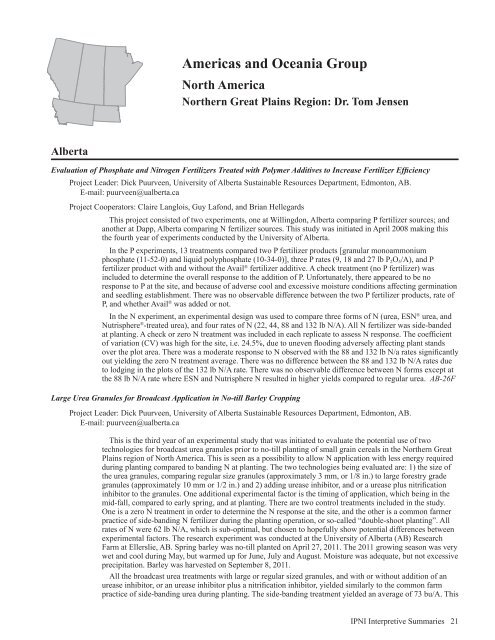Americas and Oceania Group - International Plant Nutrition Institute
Americas and Oceania Group - International Plant Nutrition Institute
Americas and Oceania Group - International Plant Nutrition Institute
Create successful ePaper yourself
Turn your PDF publications into a flip-book with our unique Google optimized e-Paper software.
<strong>Americas</strong> <strong>and</strong> <strong>Oceania</strong> <strong>Group</strong><br />
North America<br />
Northern Great Plains Region: Dr. Tom Jensen<br />
Alberta<br />
Evaluation of Phosphate <strong>and</strong> Nitrogen Fertilizers Treated with Polymer Additives to Increase Fertilizer Efficiency<br />
Project Leader: Dick Puurveen, University of Alberta Sustainable Resources Department, Edmonton, AB.<br />
E-mail: puurveen@ualberta.ca<br />
Project Cooperators: Claire Langlois, Guy Lafond, <strong>and</strong> Brian Hellegards<br />
This project consisted of two experiments, one at Willingdon, Alberta comparing P fertilizer sources; <strong>and</strong><br />
another at Dapp, Alberta comparing N fertilizer sources. This study was initiated in April 2008 making this<br />
the fourth year of experiments conducted by the University of Alberta.<br />
In the P experiments, 13 treatments compared two P fertilizer products [granular monoammonium<br />
phosphate (11-52-0) <strong>and</strong> liquid polyphosphate (10-34-0)], three P rates (9, 18 <strong>and</strong> 27 lb P 2 O 5 /A), <strong>and</strong> P<br />
fertilizer product with <strong>and</strong> without the Avail ® fertilizer additive. A check treatment (no P fertilizer) was<br />
included to determine the overall response to the addition of P. Unfortunately, there appeared to be no<br />
response to P at the site, <strong>and</strong> because of adverse cool <strong>and</strong> excessive moisture conditions affecting germination<br />
<strong>and</strong> seedling establishment. There was no observable difference between the two P fertilizer products, rate of<br />
P, <strong>and</strong> whether Avail ® was added or not.<br />
In the N experiment, an experimental design was used to compare three forms of N (urea, ESN ® urea, <strong>and</strong><br />
Nutrisphere ® -treated urea), <strong>and</strong> four rates of N (22, 44, 88 <strong>and</strong> 132 lb N/A). All N fertilizer was side-b<strong>and</strong>ed<br />
at planting. A check or zero N treatment was included in each replicate to assess N response. The coefficient<br />
of variation (CV) was high for the site, i.e. 24.5%, due to uneven flooding adversely affecting plant st<strong>and</strong>s<br />
over the plot area. There was a moderate response to N observed with the 88 <strong>and</strong> 132 lb N/a rates significantly<br />
out yielding the zero N treatment average. There was no difference between the 88 <strong>and</strong> 132 lb N/A rates due<br />
to lodging in the plots of the 132 lb N/A rate. There was no observable difference between N forms except at<br />
the 88 lb N/A rate where ESN <strong>and</strong> Nutrisphere N resulted in higher yields compared to regular urea. AB-26F<br />
Large Urea Granules for Broadcast Application in No-till Barley Cropping<br />
Project Leader: Dick Puurveen, University of Alberta Sustainable Resources Department, Edmonton, AB.<br />
E-mail: puurveen@ualberta.ca<br />
This is the third year of an experimental study that was initiated to evaluate the potential use of two<br />
technologies for broadcast urea granules prior to no-till planting of small grain cereals in the Northern Great<br />
Plains region of North America. This is seen as a possibility to allow N application with less energy required<br />
during planting compared to b<strong>and</strong>ing N at planting. The two technologies being evaluated are: 1) the size of<br />
the urea granules, comparing regular size granules (approximately 3 mm, or 1/8 in.) to large forestry grade<br />
granules (approximately 10 mm or 1/2 in.) <strong>and</strong> 2) adding urease inhibitor, <strong>and</strong> or a urease plus nitrification<br />
inhibitor to the granules. One additional experimental factor is the timing of application, which being in the<br />
mid-fall, compared to early spring, <strong>and</strong> at planting. There are two control treatments included in the study.<br />
One is a zero N treatment in order to determine the N response at the site, <strong>and</strong> the other is a common farmer<br />
practice of side-b<strong>and</strong>ing N fertilizer during the planting operation, or so-called “double-shoot planting”. All<br />
rates of N were 62 lb N/A, which is sub-optimal, but chosen to hopefully show potential differences between<br />
experimental factors. The research experiment was conducted at the University of Alberta (AB) Research<br />
Farm at Ellerslie, AB. Spring barley was no-till planted on April 27, 2011. The 2011 growing season was very<br />
wet <strong>and</strong> cool during May, but warmed up for June, July <strong>and</strong> August. Moisture was adequate, but not excessive<br />
precipitation. Barley was harvested on September 8, 2011.<br />
All the broadcast urea treatments with large or regular sized granules, <strong>and</strong> with or without addition of an<br />
urease inhibitor, or an urease inhibitor plus a nitrification inhibitor, yielded similarly to the common farm<br />
practice of side-b<strong>and</strong>ing urea during planting. The side-b<strong>and</strong>ing treatment yielded an average of 73 bu/A. This<br />
IPNI Interpretive Summaries 21

















